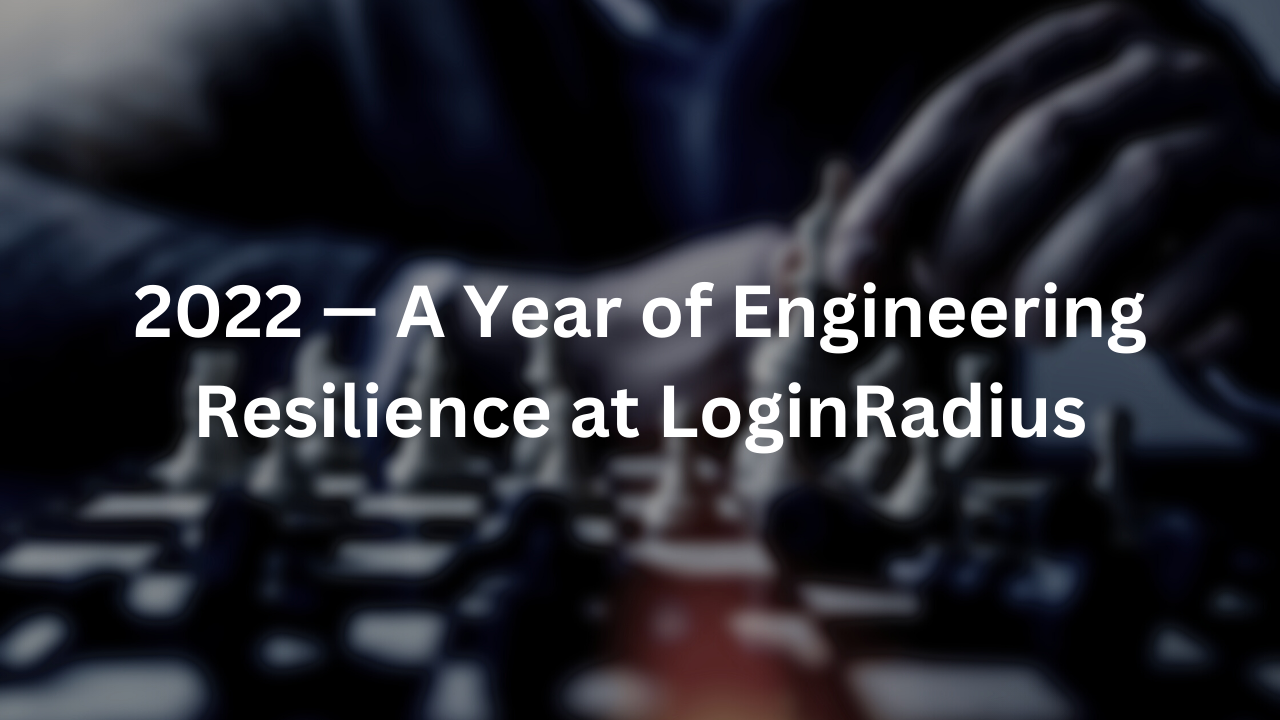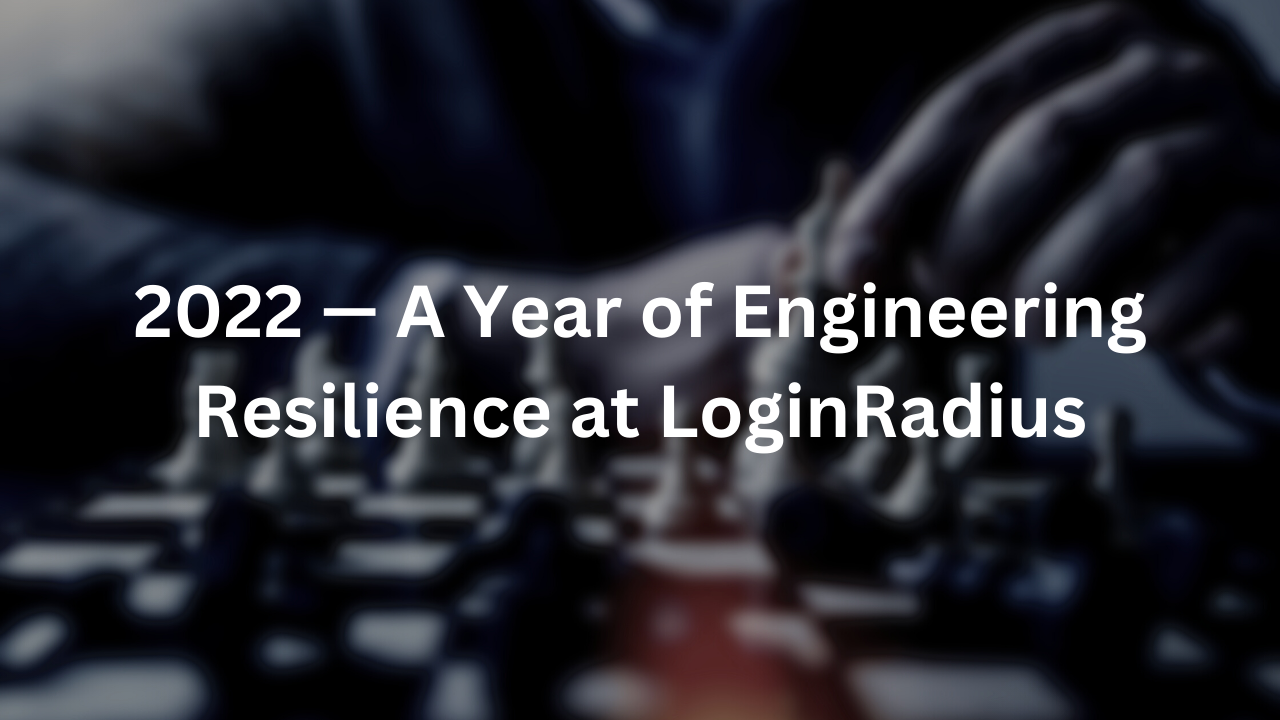2022 - An Year of Engineering Resilience at LoginRadius
The year 2022 marked a significant turning point for the LoginRadius CIAM platform, as our tech team re-engineered the entire system to meet the growing demands of our customers.

Back in 2018, our product, engineering, infrastructure, and customer teams were a happy bunch — the LoginRadius CIAM platform has evolved a lot in the previous years. It is ready to scale, serve, and support the needs of some of the biggest retail and consumer-facing brands in the world.
From 2019, the strength and capabilities of the CIAM platform enabled us to onboard some of the biggest brands we have ever worked with.
From then, things got a bit complicated — like a plot twist in your favorite story: the platform was not performing as expected in terms of scalability and latency, and it was difficult to believe we weren’t delivering up to the standards I had set for ourselves.
2020: Why LoginRadius CIAM Struggled to Deliver Cutting-Edge Performance?
From the first day we started working on LoginRadius, we knew that performance was the Achilles heel for our customers who run consumer-facing applications.
In a world where brands like Amazon, Google, and Netflix have pushed the bar for end-user experience, we wanted to enable our customers’ brands globally to deliver similar experiences to their end users, which is so fundamental to LoginRadius.
After we onboarded some of the bigger brands, special business situations and use cases caused engineering issues we had never observed before, thanks to the scale and demands of the workloads and requirements we were dealing with.
We faced performance lags in terms of scalability and latency. To address this, firstly, we launched a comprehensive root cause analysis (RCA) that surfaced sub-optimal processes and mechanisms in terms of time-to-release, automation, and legacy complexities.
The finding from the RCA has challenged our assumptions and helped us remap our priorities: No matter what, our platform has to deliver excellence for our customers of all sizes.
2021: An Year of Engineering Resolve
We are a world-class engineering team. Since its inception, engineering problems have intrigued us — in fact, that’s how LoginRadius was born.
And the time has come again to test our resolve and dedication: how do we re-engineer the LoginRadius CIAM Platform delivers a high-throughput, low-latency, and lightning-fast end-user experience?
One discussion I had strikingly comes to mind: our platform is already the strongest technological offering in the market. So, we created the strongest platform — yet that isn’t meeting our standards. If we’re going to deliver something much better, our engineering team is the one to rebuild it.

We initiated research and auxiliary processes to discover opportunities, analyze technologies, strategize platform re-engineering, and plan required upgrades.
In this phase, we focused and worked confidently with commitment yet cautiously. We knew, as with the stock investments corollary, past performance is not a precise indicator of future performance. Likewise, the technology world has changed so much, and our ability to unlearn, relearn, and solve complex engineering problems was put to the test.
2022: An Year of Engineering Resilience and High-Performance Outcomes
As we researched and planned a strategy to upgrade our CIAM platform, we focused on four key areas: platform architecture, underlying technologies, automation, and process improvements. For each focus area, we achieved the following outcomes.
Improving Scalability and Latency
APIs are fundamental to our CIAM platform and how we deliver core services to customers. In order to achieve breakthrough scalability and ultra-low latency, we started by focusing on upgrading the performance of our APIs.
The then-existing APIs were built with .NET Core, whose performance and infrastructure usage was not satisfactory with respect to the scale of requests. To solve this, we concluded through research that we must rebuild our APIs with Go Lang. Our lead architect Vijay Singh Shekhawat has written an excellent account of this transition: Why We Re-engineered LoginRadius APIs with Go?
In addition to the high-performance API upgrades, we made a lot of minor improvements to the platform and deprecated legacy technologies with modern, performance-focused technologies.
Optimizing Complexities in Our Processes and Platform
Previously, we employed a sequential development approach for individual components to create a specific feature. This approach often resulted in delays and hindered progress, as roadblocks or issues in any component would block each other and require multiple iterations to address missing or updated elements. This resulted in longer-than-anticipated development times and subpar quality.
However, we have now adopted a parallel development approach, where all components of a feature are developed simultaneously, and any missing or updated elements are addressed in real-time. This allowed us to release all components of a feature at the same time, ensuring greater efficiency and higher quality outcomes.
Leveraging Automation
The existing level of automation wasn’t enough for the speed at which we wanted to develop new features and address existing performance lags.
We rigorously worked on automation that resulted in 99% automation in our test cases for APIs and the LoginRadius platform, along with other minor workflows. It helped us deliver new releases and improvements faster, which also meant we could accommodate additional customer requirements on the fly within a defined scope.
The Results
All of our continuous efforts, strategic rethinking, and deeper involvement in re-engineering our platform have resulted in the following:
- Improved system stability and updates: Our customers have appreciated the upgrades in performance, latency, and throughput. And we haven’t faced reliability and performance issues so far.
- Our system throughput has generalized capabilities to serve 30k RPS (requests per second), which we can scale on-demand to 100k RPS or even much higher.
- Application startup time optimized from 120 seconds to 2 seconds — our biggest breakthrough yet in achieving superior on-demand scalability.
- We simplified system architecture complexity by 45%, making it more efficient to develop new capabilities and seamlessly accommodate special-case customer requirements.
All the engineering efforts have led to remarkable improvements in our identity platform, including increased concurrency and throughput, allowing us to quickly handle high volumes of end-user requests and traffic.
Another outcome of this re-engineering process has been a 40% reduction in infrastructure costs, showcasing our commitment to optimal engineering while delivering cutting-edge capabilities to our customers cost-efficiently.
As a testament to our progress, the latest analysis from Forrester on CIAM (Customer Identity And Access Management, Q4 2022) has reported, “[LogiRadius’s] scale of large deployments is ahead of the competition.”
In Conclusion
This transformation has resulted in numerous substantial improvements and has positively impacted our customers and their end users.
We continually strive to push the limits of technology and maintain a forward-thinking approach.
Originally published on LinkedIn



